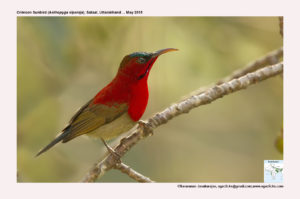Crimson Sunbird

Crimson Sunbird Aethopyga siparaja
Etymology:
- Aethopyga : Greek word aithos – fire, burning heat; puge– rump
- Siparaja : Malay name Sipa raja for the Sunda Crimson Sunbird
Vernacular Names:U.P.: Phulchuiya, Guj: Phulraj, Mal: Tenkili, Mar: Kirmijisuryapakshi
Distribution in India: Resident of Himalayas and Hills of East and North East of India.
Description: Size of male is 11·7–15 cm, wt. of male is 4·8–9 g; Size of female is 10 cm, wt. of female is 5–6·9 g. The male of nominate race has forehead to centre of crown in glossed purple-green, hindcrown and side of head to back and lesser upperwing-coverts are crimson, rump is yellow, uppertail-coverts and tail are black ,uppertail-coverts sometimes glossed green, elongated central rectrices are metallic purple. The upperwing feathers are dark brown and edged olive; chin and throat to breast are scarlet, metallic purple-blue on moustachial streak, underparts are olive-grey; iris is dark brown; upper mandible is dark brown and black at base, lower mandible is horn-brown and legs are dark brown. The female is greyish-olive on crown, nape and mantle, back is olive, rump and uppertail-coverts are olive-yellow; tail is black, edged olive on base of outer webs, outer webs are tipped pale grey, central rectrices are olive, wings are dark brown, edged ochraceous olive; throat is light grey, sometimes with some dull red, breast is olive-grey, rest of underparts are light olive, some yellowish streaking on upper belly, undertail-coverts are yellow, and long flank feathers are yellowish-white; bare parts similar as male. The juvenile male is like adult female, but has chin, centre of throat, breast, mantle and shoulders coloured as scarlet and yellow patch on back and uppertail-coverts. The juvenile female is greyer and less yellow than adult.
Habitat: It is found in mangroves, heavily disturbed and regenerating secondary forests, forest edge, also parkland, secondary growth and scrub in open country, coastal vegetation, coconut groves, plantations and gardens, around flowering and fruiting trees. It is found from foothills to 1700 m.
Food habits: It eats insects, spiders and nectar. It forages in pairs and singly, also in family parties, Itforages low down but occasionally in canopy. It drinks flowers of nectar by piercing corolla bases.
Breeding habits: They breed in Feb–Oct in Indian Subcontinent; Jan–Feb and Apr–Jun in Myanmar; Mar, Jun and Jul in Malay Peninsula Apr in Sumatra and Borneo, in all months except Aug, Oct and Nov in W Java, and Feb–Jun in Philippines. The nest is a concealed, attenuated, pear-shaped bag, side entrance usually with porch, woven from fine grass, palm fronds, vegetable down, rootlets, moss and cobwebs, decorated with oddments such as cobwebs or bark, or clothed with rootlets on outside, attached to tendrils or palm fronds ,above ground, sometimes under overhanging bank. They lay a clutch of 1–3 eggs. The nest is parasitized by Asian Emerald Cuckoo.